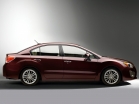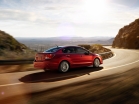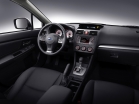Subaru Impreza sedan test drive since 2012 sedan
Subaru Impreza Wrx car overview
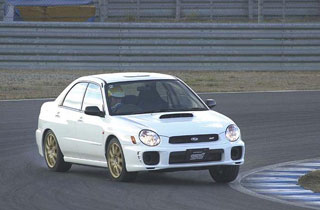 WRX STI-RA-C
WRX STI-RA-C Impreza lives to ride. As for its best STI Typera model, it will not be an exaggeration to say that the speed is the main value of its existence. The current Impreza, which appeared in August 2000, received a significant improvement in the chassis. However, along with this, the developers began to strive to increase stability in management, so there were rumors that the steering wheel did not turn tight, and the popularity of the model has become even lower. Naturally, Subaru did not observe indifferently after such a situation. She released an unexpected additional model on the stage, which can be called a shot for resurrection. This is WRX STI-RA-C.
Having begun to develop this car, Subaru announced the creation of the fastest and most powerful 2-liter model. In addition, the emphasis was not only on speed and power, but also on honed control, ensured by good main characteristics of the chassis. Namely, in modifications, with the aim, there was an even greater improvement in running and high -speed qualities inherent in WRX models.
This is not just a simplified and lightweight model
There were rumors for a long time: at the end or beginning of the year, a lightweight version will appear. Nevertheless, the appearance of this machine was a surprise. The weight of the car is 1310 kg with 17-inch tires and 1290 kg with 16-inch tires. Indeed, the weight relative to the base model is reduced by 90 kg. They removed an additional front bumper frame and the rear spoiler, made of thinner sheets of the door, roof, trunk lid and inserted thinner glasses. They used (for 17-inch tires) BBS cast wheels, each of which is lightly facilitated by about 2 kg. And, ultimately, even a fuel tank was made more compact, reducing its volume from 60 to 50 liters. In addition, since this car is a basic model for sports competitions, they removed airbags from the driver's and neighboring seats, etc. Indeed, a thorough weight reduction has been carried out.
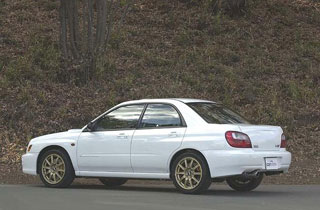 On the other hand, many improvements were made in the chassis and drive system. In the front suspension, a transverse support rod was added to increase supporting stiffness; reinforced places of attachment of crossbars; The altered design of the lower levers made it possible to increase the contact of the tires with the road in corners (the tilt of the front tires is increased from 3O30 'to 450'). As a result, the wheeled base increased from 2525 mm to 2540 mm. In the drive system, a differential of high friction from the back is installed, as well as standard equipment is made by the transmission oil cooler to increase reliability in competitions. In addition, the Bridgestone Potenza Re-070 (17 inches) tires are installed, specially designed for modification C. They have high characteristics at the level of half-drives, in particular, the external tread and combined coating, which allows you to show good adhesion as it heats.
On the other hand, many improvements were made in the chassis and drive system. In the front suspension, a transverse support rod was added to increase supporting stiffness; reinforced places of attachment of crossbars; The altered design of the lower levers made it possible to increase the contact of the tires with the road in corners (the tilt of the front tires is increased from 3O30 'to 450'). As a result, the wheeled base increased from 2525 mm to 2540 mm. In the drive system, a differential of high friction from the back is installed, as well as standard equipment is made by the transmission oil cooler to increase reliability in competitions. In addition, the Bridgestone Potenza Re-070 (17 inches) tires are installed, specially designed for modification C. They have high characteristics at the level of half-drives, in particular, the external tread and combined coating, which allows you to show good adhesion as it heats. In addition, the engine has changed significantly. The fist shaft began to be located on top, which contributes to good work at high speeds. In addition, ball bearings were used in the turbine, which increased its reaction. The internal partition in the absorption pipe was removed, which reduced the resistance during absorption. A related electronic control unit is also used. As a result of all this, the maximum torque is increased by 1.2 kg-m, compared with the base model, and reaches 39.2 kg-m. Thus, the modification C is not a basic machine for competitions, which is simply reduced in weight. The obvious idea was put into it that they do not lose on such a machine.
All basic characteristics have increased significantly
The steering can be said in one word: great! In any case, the steering wheel turns well. And fast.
We carried out the current demonstration on the eastern shortened route. On a direct segment, switch the gears, unwinding the motor to 6300 rpm. On the scoreboard showing 200 m to the end of the segment, the speedometer arrow easily crosses after 180 km/h and approaches 200 km/h. Then the turn-with braking, turn right, lowering the gears from the 6th to the 3rd speed. In previous Typera modifications, the front wheels were gradually taken out at this moment. In modification C, if you press the accelerator, when accelerated on the front wheels, the strength of the thrust begins to act and as if it pulls them from the corner. Then there are repeated turns to the left and right along the winding area. And here the car is easy, and its heaviness is almost not felt. If the accelerator is slightly released when turning, then the back will obediently slide.
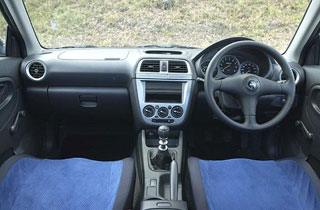 After leaving the winding area, a straight area of \u200b\u200b500 m long begins again. Here, the speedometer shooter crosses 180 km/h. It seems that there is a sharp acceleration not due to power, but due to torque. If you promote the engine up to 8000 rpm, the beginning of the red zone, then the machine is gaining speed not quickly enough. If you promote to smaller values \u200b\u200b(7000 rpm, 6500 rpm, 6000 rpm), the dynamics improves markedly. The best site is, according to 6200 to 6500 rpm. Apparently, such a result is generated by a limitation of up to 280 hp. With a torque of 39.2 kg-m, the power should be about 350 hp. Since the car is turbine, an increase in torque does not mean an increase in power at all. However, there is no doubt that high speed growth is significantly limited.
After leaving the winding area, a straight area of \u200b\u200b500 m long begins again. Here, the speedometer shooter crosses 180 km/h. It seems that there is a sharp acceleration not due to power, but due to torque. If you promote the engine up to 8000 rpm, the beginning of the red zone, then the machine is gaining speed not quickly enough. If you promote to smaller values \u200b\u200b(7000 rpm, 6500 rpm, 6000 rpm), the dynamics improves markedly. The best site is, according to 6200 to 6500 rpm. Apparently, such a result is generated by a limitation of up to 280 hp. With a torque of 39.2 kg-m, the power should be about 350 hp. Since the car is turbine, an increase in torque does not mean an increase in power at all. However, there is no doubt that high speed growth is significantly limited. So, the test continues. Turn right (turn 300R). Here we switch to the fourth gear, and in turning the speed is about 150 km. But the wheels cling perfectly to the roadway and obediently rotate, completely not showing a capricious character. The speed grows rapidly, and before the next winding turn reaches 175 km/h. We slow down, lowering the speed to the third and turning the steering wheel to the left to failure. The load decreases, the rear tires begin to slide, and light resistance occurs. Working with shifts, we pass the second bend with zero ski.
Even the previous generation Impreza, which was called a driving machine, could not demonstrate such art when turning at high speed. On modification with this can be done quite freely, although it cannot be said that it is playful. The feeling of stability of the car is close to the outstanding, and besides, the sliding speed is low, and the machine can be controlled with confidence. The main thing is not to be nervous.
This method of modification of the car can be called sharp. This is not just an increase in combat power. Thoughts and aspirations assigned to the Subaru Impreza model are clearly manifested in this modification of S.
Source: CarView.co.jp

